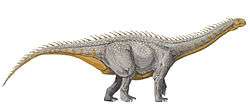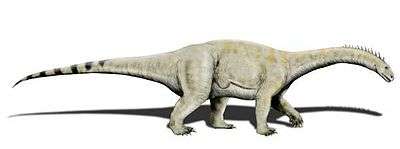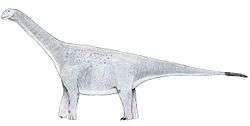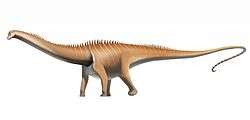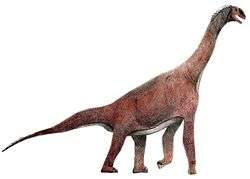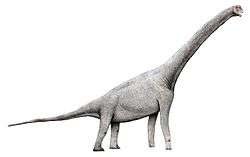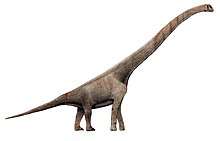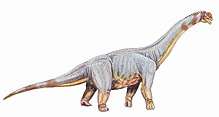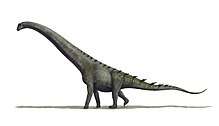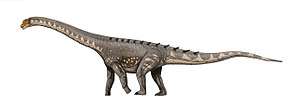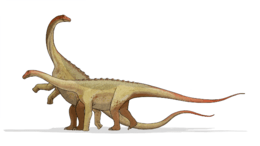Turiasauria
| Turiasaurs | |
|---|---|
| Scientific classification | |
| Kingdom: | Animalia |
| Phylum: | Chordata |
| Clade: | Dinosauria |
| Order: | Saurischia |
| Suborder: | †Sauropodomorpha |
| Clade: | †Sauropoda |
| Clade: | †Eusauropoda |
| Clade: | †Turiasauria Royo-Torres et al., 2006 |
| Genera[1] | |
Turiasauria is an unranked clade of primitive sauropod dinosaurs known from Middle Jurassic to Early Cretaceous deposits in Europe and North America.
Description
Turiasauria was originally erected by Royo-Torres et al. (2006) to include Turiasaurus, Galveosaurus and Losillasaurus, all of which hail from the Villar del Arzobispo Formation (Tithonian-Berriasian) of Spain. Turiasuria was defined by the authors as "all Eusauropoda closer to Turiasaurus riodevensis than to Saltasaurus loricatus".[2]
Cladistic analysis (Royo-Torres et al., 2006; 1927) of 309 characters and 33 taxa suggests that the turiasaurians lie outside the Neosauropoda and form a monophyletic group. The clade is diagnosed by the presence of vertical neural spines, posterior centroparapohyseal laminae on the dorsal vertebrae, the absence of pre- and postspinal laminae on the dorsal vertebrae, the absence of a scapular acromial crest, the presence of a prominent humeral deltopectoral crest, medial deflection of the proximal end of the humerus, and a distinct vertical ridge on the caudal side of the distal half of the ulna.
The biogeographic and stratigraphic ranges of the Turiasauria remain unclear, but Royo-Torres et al. (2006; 1927) hypothesize that the clade probably represents a pre-Tithonian sauropod radiation originating in Europe. As yet unrecognized members of the group may be indicated by Turiasaurus-like teeth from the Jurassic of Portugal, France, and England (presently referred to the genera Neosodon and Cardiodon).
Turiasaurus demonstrates that the evolution of enormous body size was not restricted to neosauropod clades such as the Diplodocidae and Titanosauria, but developed independently at least once in a lineage of more basal sauropods, the turiasaurians.
A 2009 thesis published by José Barco proposed that neither Galveosaurus nor Losillasaurus were turiasaurians.[3] Later, a master thesis by Francisco Gascó (2009) and Royo-Torres et al. (2009) reaffirmed the validity of Turiasauria.[4][5]
Remains of a very large species of Turiasaur, not yet formerly identified, has recently been unearthed in Charente, West France [6]
References
- ↑ Holtz, Thomas R. Jr. (2012) Dinosaurs: The Most Complete, Up-to-Date Encyclopedia for Dinosaur Lovers of All Ages, Winter 2011 Appendix.
- ↑ Royo-Torres, R.; Cobos, A.; Alcalá, L. (2006). "A Giant European Dinosaur and a New Sauropod Clade". Science. 314 (5807): 1925–1927. doi:10.1126/science.1132885. PMID 17185599.
- ↑ José Luis Barco Rodríguez, Sistemática e implicaciones filogenéticas y paleobiogeográficas del saurópodo Galvesaurus herreroi (Formación Villar del Arzobispo, Galve, España), 2009, Universidad de Zaragoza.
- ↑ Gascó, F (2009): Sistemática y anatomía funcional de Losillasaurus giganteus Casanovas, Santafé & Sanz, 2001 (Turiasauria, Sauropoda). Universidad Autónoma de Madrid.
- ↑ Royo-Torres, R.; Cobos, A.; Aberasturi, A.; Espilez, E.; Fierro, I.; González, A.; Luque, L.; Mampel; Alcalá, L. (2009). "High European sauropod dinosaur diversity during Jurassic-Cretaceous transition in Riodeva (Teruel, Spain)". Palaeontology. 52 (5): 1009–1027. doi:10.1111/j.1475-4983.2009.00898.x.
- ↑ Allain, Ronan, editor (2017): Dinosaures. Les géants du vignoble. Angoulême: Eidola éditions, 248 p.
Sources
- Barco, J. L., Canudo, J. L., Cuenca-Bescós, G. & Ruíz-Omeñaca, J. I., (2005): Un nuevo dinosaurio saurópodo, Galvesaurus herreroi gen. nov., sp. nov., del tránsito Jurásico-Cretácico en Galve (Teruel, NE de España). Naturaleza Aragonesa: Vol. 15, pp 4–17
- Casanovas, M. L.; Santafe, J. V.; Sanz, J. L. (2001). "Losillasaurus giganteus, un nuevo saurópodo del tránsito Jurásico-Cretácico de la Cuenca de "Los Serranos" (Valencia, España)". Paleontologia i Evolució (32–33): 99–122.
